
|

|
|
Home Site Search Contact Us Subscribe
|
|
|
INSIGHT: Iconic Architecture in the Digital Age New technologies are helping to transform architectural surfaces far beyond the traditional canons of architecture. By Carlos Ferré March 23, 2010 Architects create functional, cost-effective structures that complement their surroundings with a design that is authentic, attractive, and striking to the onlooker. However, most architects aspire to do so much more. They dream of transforming useful, purpose-built structures into art forms. Just as an artist dreams of creating an immortal masterpiece, architects hope to build structures that stand the test of time – ones that are memorialized as iconic.
Iconic buildings are so much more than buildings. They are symbols of creativity and innovation. Some clearly reflect signs of the times, while others are way ahead of their time. Either way, iconic design thrives to a greater extent in the absence of boundaries and restrictions. Think how different the pyramids would look if there were building codes in place in ancient Egypt?
Today, buildings must be sturdy enough to last decades (even centuries), compliant enough to meet building code standards and public safety requirements, and conventional enough to complement the formulaic style du jour. With all of these “guidelines,” is iconic even achievable?
Absolutely, thanks to technology. Architects have long used computers to automate the design process, but what about incorporating technology into the design itself? Digital mediums have opened a whole new design element for architects, offering fresh avenues for creating buildings that are simultaneously signs of the times and testaments to the future. Today’s digital technology offers the perfect canvas for creating iconic architecture.
Technology and Architecture
When properly and creatively applied, digital technology can transform buildings from static objects to interactive communications platforms. If you think “digital technologies” is a catch-phrase for clunky digital billboards cluttering up the sides of buildings, think again. In fact, digital displays have come a long way in recent years. Forget clunky billboards; think sleek, transparent building façades that let both the architectural design and the view from inside the building shine through.
Advances in digital building façades offer architects a whole new way to be expressive in the digital age. Also called digital media façades, they transform structures from static to dynamic, from hardly noticed to objects of attention, and from silent to communicative. Digital media façades are not just for new buildings; they can help revitalize older buildings, too. Rather than blending into the urban fabric, buildings outfitted with digital media façades can take center stage as powerful signs of the times.
Digital media façades offer the 21st-century way to make buildings stand out. The RTKL-designed 57-story Grand Indonesia Tower in Jakarta, for example, is wrapped in a 60,000-square-foot video screen that covers the entire front of the office tower. According to its architect Darryl Yamamoto (now with Austin Veurn Robbins Partners/ AVRP), in an article in SignIndustry.com, “Video screens that completely cover a building’s surface change the equation of how a building occupies that space. In a sense, a video screen covering a building surface places it in a fourth dimension, where pictorial and iconic imagery now become a representational feature of how the building presents itself.”
Digital building façades enable architectural structures to inform and communicate in a whole new way, defining a whole new dimension of “functional” in the process. This kind of iconic structure is especially suitable for urban, high-traffic locations where information sharing – in the form of words or multimedia images, or a combination of both – and consumer engagement is in high demand. For instance, the AmericanAirlines Arena, designed by Arquitectonica and 360 Architecture, recently installed a 3,400-square-foot media façade in downtown Miami. This is an example of a display that not only harmonizes building form and function, but also offers significant revenue generating opportunities.
What’s the digital technology payoff for building owners? They gain a medium for advertising sales. This type of monetization can help provide an ROI for construction costs and generate perpetual revenue opportunities. During the bidding process, architects who can offer this advantage may be more likely to be selected.
Choosing a Technology
When evaluating digital media façade technology for inclusion in a new design or a building update, there are five key elements to consider: transparency, weight, flexibility, durability, and energy efficiency.
Transparency is arguably the most important consideration. It’s imperative that the view from inside the building looking out not be obstructed by the installation. Transparency also ensures that the installation is not an “eyesore”; when the screen is off, it seamlessly blends into the architecture. Technologies like Mediamesh® – designed and manufactured by two German companies, ag4 and GKD – are up to 70% transparent, offering significant aesthetic advantages.
Weight is a critical factor in the evaluation process as well. Most technologies are extremely heavy, and require significant structures to support their added weight. Look for a technology that is light enough not to require the extra cost or clunky look of additional support structure.
When evaluating flexibility, consider how well the installation conforms to a building’s shape, especially if it’s not a standard linear construction. The ideal digital media façades are those that can be installed in locations where other signage is not feasible, such as over glass or on round-shaped buildings. As architecture is not unilateral, this element plays an important role in keeping the originality of the building. A companion feature to flexibility is elegance – the degree to which images on the screen appear to float of the building surface, as opposed to looking as if they are flat and lifeless.
Durability is obviously a desirable attribute. Is the technology temperature-tolerant and weather-resistant? Will it withstand hurricane-force winds, extremely high or low temperatures and still maintain optimal operation?
Energy efficiency is definitely worth evaluating not only because of the growing demand for environmental stewardship, but also for more practical cost-saving reasons. For example, Mediamesh installations use just one-sixth the electricity of conventional LED boards and provide passive solar gain from the sun. This translates into real-cost savings that can help defray the cost of the installation over time.
New Frontiers in Architecture
There are very few truly innovative ideas in the field of architecture. Still, thanks to digital technology, architecture has evolved into something that was unimaginable 50 years ago. These new technologies are helping to transform architectural surfaces far beyond the traditional canons of architecture. In a society increasingly driven by imagery and real-time information, digital building façades offer a unique delivery medium packaged in an aesthetic design. The combination of transparency and digital technology allows architects to create iconic buildings that reach audiences in a way “traditional” architectural methods never could – harmonizing building form and function and creating revenue opportunities for building owners in the process. Digital media technologies are helping to define a new frontier for architecture. Based on the growing popularity of digital media façades, it’s clear that a building’s ability to serve as an information vector will be one way to define iconic architecture in the digital age.
Carlos Ferré is the Vice President of Design and Installation at A2aMEDIA and a practicing architect. Carlos helped A2aMEDIA to become the first company to bring Mediamesh® technology to the U.S. and Canada through an exclusive agreement to purchase and sell the technology across the globe. He has extensive experience in the industry including co-founding an architectural firm specializing in curtain wall technology and large-scale building façades. He has also played key roles in the development of many significant projects, including the AmericanAirlines Arena 3,400-square-foot Mediamesh installation, the 70-story Bank of China in Hong Kong, the 73-story U.S. Bank Tower in Los Angeles, and the Louvre Pyramid in Paris. |
(click on pictures to enlarge) 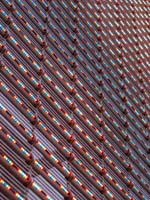 ag4/GKD Five key elements to consider when evaluating digital media façade technology: transparency, weight, flexibility, durability, and energy efficiency. 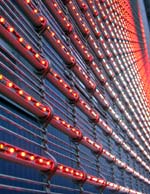 ag4/GKD Technologies like Mediamesh, designed and manufactured by two German companies, ag4 and GKD, are up to 70% transparent, offering significant aesthetic advantages. 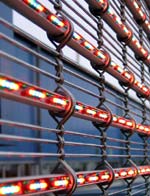 ag4/GKD Mediamesh installations use just one-sixth the electricity of conventional LED boards and provide passive solar gain from the sun. 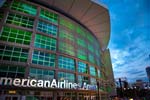 A2aMEDIA AmericanAirlines Arena, designed by Arquitectonica and 360 Architecture, now sports a Mediamesh Installation.  A2aMEDIA AmericanAirlines Arena 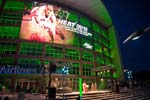 A2aMEDIA AmericanAirlines Arena 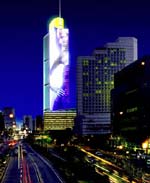 StandardVision Grand Indonesia Tower, Jakarta, designed by RTKL |
© 2010 ArchNewsNow.com